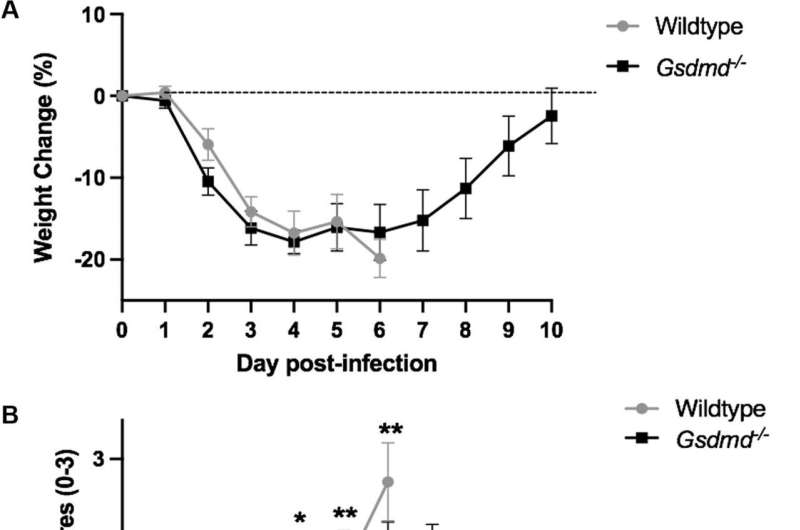This article has been reviewed according to Science X's editorial process and policies. Editors have highlighted the following attributes while ensuring the content's credibility:
fact-checked
peer-reviewed publication
trusted source
proofread
Researchers find a clue to fighting fatal influenza

When influenza (or flu) reaches the critical stage, there are no specific treatments available for patients. Now new research has identified a key to this sometimes fatal condition, and opened the door to possible cures.
The influenza virus attacks the person's respiratory system, causing symptoms such as fever, cough, sore throat, body aches, and fatigue. These symptoms can range from mild to severe, and in some cases, can lead to hospitalization or even death.
In severe cases of flu, the body's immune system overacts, leading to hyperinflammation and damage to the lungs. There are currently no effective treatments for severe influenza in the clinic.
The latest research by Associate Professor Michelle Tate and her team at Hudson Institute of Medical Research, published in the journal Cell Death and Disease, is working to understand exactly how the virus induces inflammation and lung damage.
Gasdermin D amplifies influenza response
Ph.D. student Sarah Rosli explains, "The influenza virus primarily infects the epithelial cells lining our airways and damage to this layer of cells leads to life-threatening disease."
"We have made significant advances in understanding how the influenza virus induces inflammation," she said. "However, the pathways which promote epithelial cell death and their role in promoting hyper-inflammation and severe influenza disease are not fully understood."
"But now we have identified a protein in lung epithelial cells which promotes hyper-inflammation and cell death opening avenues for the development of new drugs that target this protein.
The protein in question is Gasdermin D, which forms pores or holes on the membranes of cells, causing the cells to swell. The cell then explodes, releasing cellular contents, and this amplifies the inflammatory response.
"To develop new drugs, we first need to understand how influenza infections become fatal," Rosli said. "So, this latest research has identified an exciting new opportunity to target those host responses, rather than the virus itself."
How influenza becomes fatal
Influenza infections can become fatal when the virus causes severe damage to the respiratory system, making it difficult for the body to get enough oxygen. This can lead to respiratory failure, which is the most common cause of death.
In some cases, the virus can also cause secondary bacterial infections, which can further weaken the body and be potentially deadly.
While most people recover from flu without any complications, certain groups of people are at a higher risk of developing severe symptoms. These include young children, older adults, pregnant women, and people with underlying health conditions such as asthma, diabetes, or heart disease.
In these individuals, the influenza virus can lead to serious complications such as pneumonia, edema or fluid in the lungs, and even death.
Understanding influenza infections
Influenza viruses are constantly changing, making it difficult for our bodies to build immunity against them. This is why flu vaccines are updated every year to protect against the most prevalent strains of the virus.
The best way to prevent influenza infections from becoming fatal is to take preventive measures. The most effective way to do this is by getting a flu vaccine every year. The flu vaccine not only protects you from getting the flu but also reduces the severity of symptoms if you do get infected. It also helps prevent the spread of the virus to others.
Other preventive measures include washing your hands frequently, avoiding close contact with sick individuals, and staying home when you are sick.
It is important to recognize the symptoms of flu and seek medical attention if they become severe. If you experience difficulty breathing, chest pain, severe vomiting, or confusion, seek medical help immediately. These symptoms could indicate a more serious complication of the flu and require immediate treatment.
More information: Sarah Rosli et al, Gasdermin D promotes hyperinflammation and immunopathology during severe influenza A virus infection, Cell Death & Disease (2023). DOI: 10.1038/s41419-023-06258-1



















